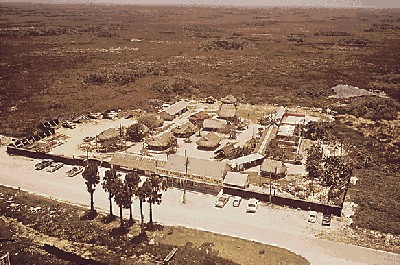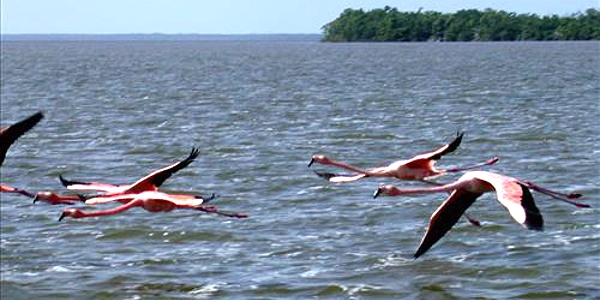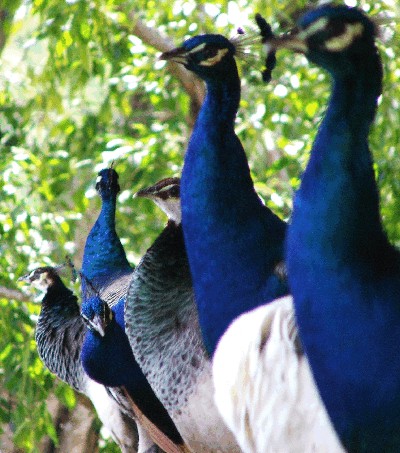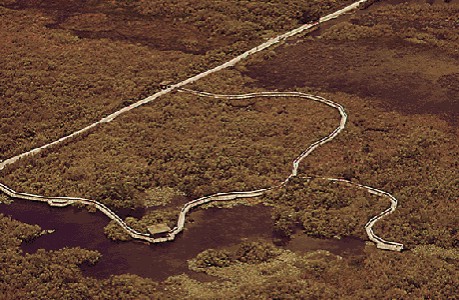
Photo above: Seminole Indian Village along the Tamiami Trail, circa 1972. Courtesy National Archives.

Everglades National Park
Before the mouse roared into Florida several decades ago, a trip to Florida was not complete without a visit to several attractions, ... St. Augustine, Cypress Gardens in Winter Haven, Miami Beach, and the South Florida jewel of nature, the Everglades. And the history of this part of the state, south of the mouse, is still as vibrant and entertaining as it was in bygone times. It is still as filled with the history of the lands of Florida, its marshes, its wildlife, and its Indian heritage.
Click here to Sponsor the page and how to reserve your ad.

Everglades Then
Indian Culture - On display throughout the park in private exhibits, as well as National Park exhibits, the culture of the Everglades Indians (Seminole, Miccosukee) is ever present. Pictured below left second column: two Seminole Indian women in 1941 cook cane syrup on the Seminole Indian Agency. Pictured below right: a Seminole Indian man spears garfish in 1930. The history of the modern Seminole Indian began in the early 1800's as a result of Creek and Muskogee people moving south from the Carolinas, Georgia and Alabama. Once in Florida, they became known as Seminoles, numbering nearly five thousand. During the Trail of Tears campaign when the federal government forced Indians east of the Mississippi to move west, a number of the Seminole people refused. They declared war on the U.S. Army, fighting two wars (1835-1842, 1855-1859), which saw immense casualties on both sides. Only one hundred and fifty Seminoles remained after the wars, hiding in the Everglades, where their descendents still live today.
Everglades National Park spans the southern tip of the state from the Gulf Coast to the Atlantic, a subtropical preserve that includes sawgrass prairies and cypress swamps. From its dedication in 1947 by President Harry S. Truman through today, no trip to Florida is complete without a visit to the habitat that made the state what it is. Nothing against a Disney attraction, whether that be Disney World, Epcot, or one of the other Orlando theme parks (we like them, too), but there is nothing in the world that compares to an actual alligator in the wild versus a mechanical lizard in a man-made lake.
Call it the ying to their yang, the park got its origin in the establishment of Royal Palm State Park in 1916, and through the efforts of the Tropical Everglades Park Association over the next two decades, it culminated in the establishment of 2,164,480 acres that were to be acquired, although it never quite got that large, from 1934 forward and encompass the park that would be dedicated by Truman. It did grow, however, from the 460,000 of the original size on December 6, 1947 to its present size nearly sixty years later.
Photo above: Stereograph of a man in his carriage riding through the big swamp of the Everglades in 1905, Keystone View Company. Courtesy Library of Congress. Below: Flamingos flying at mouth of Garfield Bight near the Flamingo Visitor Center in Everglades National Park. Courtesy National Park Service/Steven Tennis.

Everglades Now
History of the Everglades Itself - The Everglades, or what the Seminoles called "grassy water", has a rich history, although the history was replete with changes in philosophy as for the waters of the Everglades ecosystem. Early settlers thought south Florida and the Everglades was essentially wasteland, and urged the state legislature and Congress to drain it in the beginning part of the century. Actually, a large network of locks, and canals were subsequently created into the marshes, culminating in the controversial Central and Southern Florida Project that cut the Kissimmee River into a three hundred foot canal now half the length of its original meandering river. This project, along with the partial draining of the Big Cypress Swamp, caused a great problem in the Everglades system, which the current restoration projects hope to restore. Big Cypress Swamp is now protected as the Big Cypress National Preserve, located on the northwest side of Everglades National Park.
The Nature of the Everglades on View - Thoughout the park, trails on both land and water, traverse the far reaches of the Everglades. Pictured below; the Auhinga Trail, from 1972, shows an elevated boardwalk through a slough. The Auhinga Trail is still the place to enjoy a one-half mile trail today. Alligators, egrets, water turkeys and garfish can be seen along the side of this path during the appropriate season.
Today's Nature - Throughout the modern everglades, both remnants of past culture and today's nature abound. The center picture above shows the ruins of a traditional Seminole hut in the middle of the Everglades. On both left and right, the sites that can be seen during a walk or boat ride around the park include alligators and peacocks, while not on parade for visitors, within view for the visitor on watch.
The Auhinga Trail is just one of the many available hikes throughout the park. Other short jaunts include the Gumbo-Limbo Trail, near Royal Palm, the Pineland Trail, seven miles from the main park entrance, the Pahayokee Overlook in the river of grass, and the Mahogany Hammock Trail, through a dense jungle hardwood hammock. Longer trails are also plentiful, particularly from the Longe Pine Key area near the campground and near the Royal Palm Visitor Center, the old Ingraham Highway.
Endangered Nature - Due to the increase in development pressure throughout Florida, and water management practices that have robbed the Everglades of enough water during the wet season, as well as chemical usage and air pollution, the Everglades is now one of the most endangered parks in the nation. A concerted effort is being made to rehabilitate the Everglades and its ecosystem.
Minute Walk in History
Florida's hot, humid, and famous collections of ecosystems abound in this video that takes you on various view of the park, with a focus on the Bobcat Boardwalk Trail at the Shark Valley Visitor Center, as well as vibrant music and the sounds of Everglades nature.
T-Shirts and Souvenirs

Everglades National Park Souvenirs. Official gifts from Americabesthistory.com.

Everglades
Things You Should Not Miss
1. The film, "Everglades: River of Life" at the Ernest F. Coe Visitor Center.
2. The narrated tram ride, two hours long, at the Shark Valley Visitor Center.
3. Take a ranger guided walk, offered all year at the Royal Palm Visitor Center and in winter months from the other Visitor Centers as well.
Photo above: Alligator with open mouth in the Flamingo area of Everglades National Park. Courtesy National Park Service/USGS.
Photo above: Kuchel Visitor Center located in Orick, Redwood National Park. Kuchel has exhibits, patio talks in the summer, and beach access. Courtesy National Park Service. Below: Shark Valley Visitor Center. Courtesy National Archives.
Attendance at the Park
Attendance had been on the rise at Everglades National Park through 2005, when it drew over 1.2 million visitors, but with the gas prices rising in 2008 had fallen to just over 800,000. The Everglades had become a hot destination after the Disney invasion, rising from its 550,168 visitors in 1982. But you can't keep a good ecosystem and history of a state this fervent down forever. Travel to the Everglades and make your vacation to Florida even more special.

Visitor FAQ





